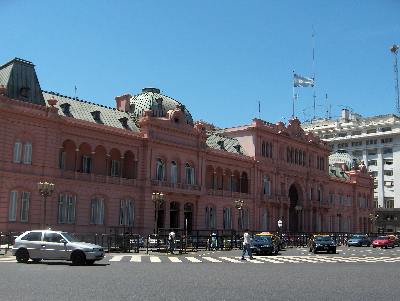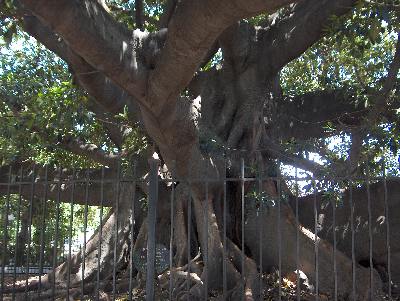 |
February 11, 2005Notes from My Trip to Buenos
Aires
|
BUENOS
AIRES, ARGENTINA--As I
mentioned last week, I am in South America visiting my daughter and her
husband’s family in Montevideo, Uruguay. They wanted my wife and I to see
Buenos Aires on the way because they have family there, and because it is such a
large and dynamic city. The city of Buenos Aires is about as big as all of
Uruguay.
After
settling in at the hotel we started our tour of the city, spending the evening
on the rejuvenated waterfront (Puerto Madero) followed by a meal at a good
restaurant. The city has many beautiful parks, buildings, and numerous statues
of former heroes. The city has survived a major crisis of confidence, since a
few years ago when they had a major financial crisis which closed the banks,
and the people took to the streets. In that period they had five different
presidents within a space of two weeks. International debts were defaulted and
the peso lost half of its value overnight. The main administrative building is
still surrounded by three-metre barricades and there are still protests. Also
protesting crimes of the past, in front of this same building are women, known
as the Mothers of the Plaza de Mayo, who march in memory of the thousands of
disappeared during the dictatorship of the 1970s and 1980s.
Canadian
money goes along way in Buenos Aires on any purchase, and there is a wide range
of excellent hotels, restaurants and stores to suit any taste. There are over
30,000 taxis that will run you around for prices cheaper than bus fair at home.
Some streets are quite narrow, while the Avenida de Julio is sixteen lanes
wide, the widest in the world. There is also a contrast of living with a lot of
poverty, but a considerable middle and upper class who live an energetic and
enthusiastic life, especially the thousands who have steady incomes now that
things are beginning to stabilize.
Early
History
Spain had
established itself in South America in 1536 when the Portuguese became a
presence and Spain sent Pedro de Mendoza and 2000 men to the mouth of the Rio de
la Plata (River) and established a community there on a hill. They got along
well with the native people, but famine and disease created conflict and the
settlement died.
In 1580
another more sophisticated Spanish settlement was established with checkerboard
streets and a protective barricade. The Plaza de Mayo is the site of this early
community. The economy and the city grew. The land was ideal for cattle with
the primary export of hides, much like Canada with its beaver pelts. The
British made a failed forty-six day attempt to capture the city in 1806. In 1816
Argentina declared independence from Spain and became the Argentine Republic.
Immigration was encouraged and by 1880 there were 300,000 people and by 1914,
over a million. Buenos Aires now has three million people, and there are eleven
million Argentineans elsewhere in the country.
 |
Unique doorways and iron-work on
Buenos Aires streets. D. Mackey photo. |
Things to
See and Do
I mentioned
the waterfront with its open spaces, restaurants and restored buildings above.
A beautiful new footbridge called “The Bridge of the Women” with a sweeping arc
symbolic of the famous tango dance. The tango is becoming popular again,
especially with tourists, with sold out shows, dance classes and dancing in the
street. The La Boca quarter with its colourful old warehouses and houses that
are now art galleries and restaurants is a great place to visit for food and
entertainment.
The
Cathedral
We spent an
interesting afternoon looking at several sites around the Plaza de Mayo. The
huge cathedral was built in 1745, modified in 1821 and 1886, and we walked
around craftsmen working on mosaic repairs on the floors. There are twelve
lateral naves in the church, including the mausoleum of General San Martin “the
Father of the Nation,” with two soldiers in full uniform on guard.
The
Cabildo
The
original colonial government building that was built in the 1700s was somewhat
diminished in size to allow for wider roads, was restored in 1939 and is a
historical gem.
 |
The Pink House (the Argentine
equivalent to the White House) with barriers for protection from protesters.
D. Mackey photo. |
The Pink
House
The huge
executive offices of the government, with the barriers mentioned above, was
painted pink at one time and stands out. It has a recently excavated
underground escape route that has been used in several times of crises. Near
the buildings mentioned above there is a huge park with a giant statue of
Christopher Columbus looking out to sea.
The Café
Tortoni
My
favourite spot was the nearby cafe Tortoni which is a long narrow establishment
in old wood, filled with paintings and sculptures and other articles for the
past. Known for its connection to tango culture, it has been a meeting place
for intellectuals, musicians and politicians for generations, including Jorge
Borges and Frederico Garcia Lorca.
 |
Mannequins of former
personalities at the Café Tortoni on Avenida de Mayo. D. Mackey photo. |
The
Recoleta District
Another one
of the eighteen walks my guidebook recommends is the Recoleta. It features
dozens of outside craft booths, old buildings and a fascinating old cemetery
with dozens of elite family mausoleums. A crowd at one turned out to be the
resting place of the famous Eva Peron, much-loved wife of a former president.
 |
One of
Buenos Aires’ giant old gum trees. D. Mackey photo.
|
I saw the
largest tree I have ever seen at the edge of the Recoleta district: the trunk
had to be about 10 feet wide, and the branches extended 150-200 feet and were
the size of full-grown trees and supported by posts to keep them from breaking.
Some of these branches extended over the courtyard of the well-known La Biela
restaurant, were we had lunch.
There were
dozens of museums, galleries, parks, a zoo and other sites that required more
time. With five days in the city, allowing for several visits to relatives and
friends, we barely scratched the surface before heading across the Rio de la
Plata by boat to Montevideo, to a smaller but equally fascinating city with a
long history. More about Montevideo next week. For more on Buenos Aires log on
to
www.bue.gov.ar.
Heritage Perspective Home Page
| 
![]() Past
Forward is now on Facebook "LIKE" us to keep in touch
Past
Forward is now on Facebook "LIKE" us to keep in touch